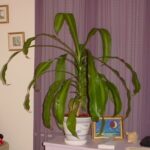Some plants that occasionally grow too include Dieffenbachia (Dumb Cane), Striped cracaena, Corn Plant, Plant, Dragon Tree, Rubber Plant, Umbrealla Tree (Schefflera), Spider Aralea (Elegantissima) and Croton. Too-tall plants need not be discarded. With a little effort, new, shorter plants can be developed from them. Several techniques are possible but generally the most successful at home is air layering. By this method roots form on a portion of the plant still attached to the base of the parent plant. The technique is simple, and few tools or supplies are needed.
Necessary materials include a sharp knife, piece of plastic about 10 inches square, sphagnum moss, and electrical tape or wire ties such as used to close plastic garbage bags. Additional materials that may be helpful include a toothpick and rooting hormone. Air layering is a process in which the stem or bark is wounded to stimulate root formation directly above the wounded area. The injured area is covered with a material to give the moist newly forming root conditions that favor their growth and development.
Sphagnum moss is generally the best and easiest rooting material to work with for air layering. It is usually available from nurseries and garden centers. To prepare for air layering, take about two handfuls of the dried material for each layer to be made, Place it in water, and allow it to become thoroughly soaked. Then remove it from the water, and squeeze out the water so that it does not drip. At that point if it is ready for use, use.
Next prepare the plant for air layering. Select an area about one foot from the tip of the branch or terminal shoot. Remove the leaves for about 6 to 8 inches below this point. At the center of this bare area, make two cuts completely around the stem, about one half inch apart and against the woody part of the stem. Remove all the bark between the two cuts. Taking the knife, scrape the inner wood to make sure all bark is removed. If the plant is not a woody type, it may be easier to make a single cut about two-thirds of the way through the thick stem, being careful not to cut off the branch entirely.
Place the toothpick into the cut to prevent it from healing together. If possible, dust the cut or girdled area with a rooting hormone. Next take the prepared sphagnum moss and press it into a ball around the wounded area. Wrap the square of plastic around the ball so that it will be watertight, and tie it around the plant stem at the top and bottom of the plastic. Watch for the formation of roots. When they become visible, remove the plastic and cut off the top from the plant with its new roots. Pot it as any other new plant. Cover the top of new plant with plastic for about a week while it gets established. The base of the parent plant will often sprout new shoots after the top has been removed.
Houseplants for Dummies, by Larry Hodgson.



